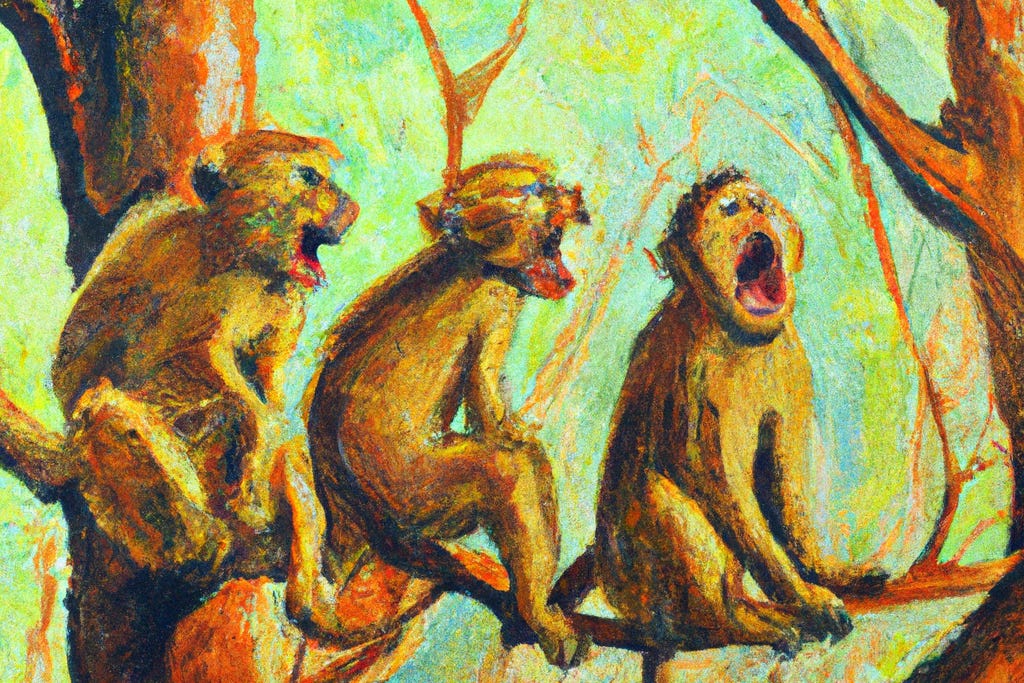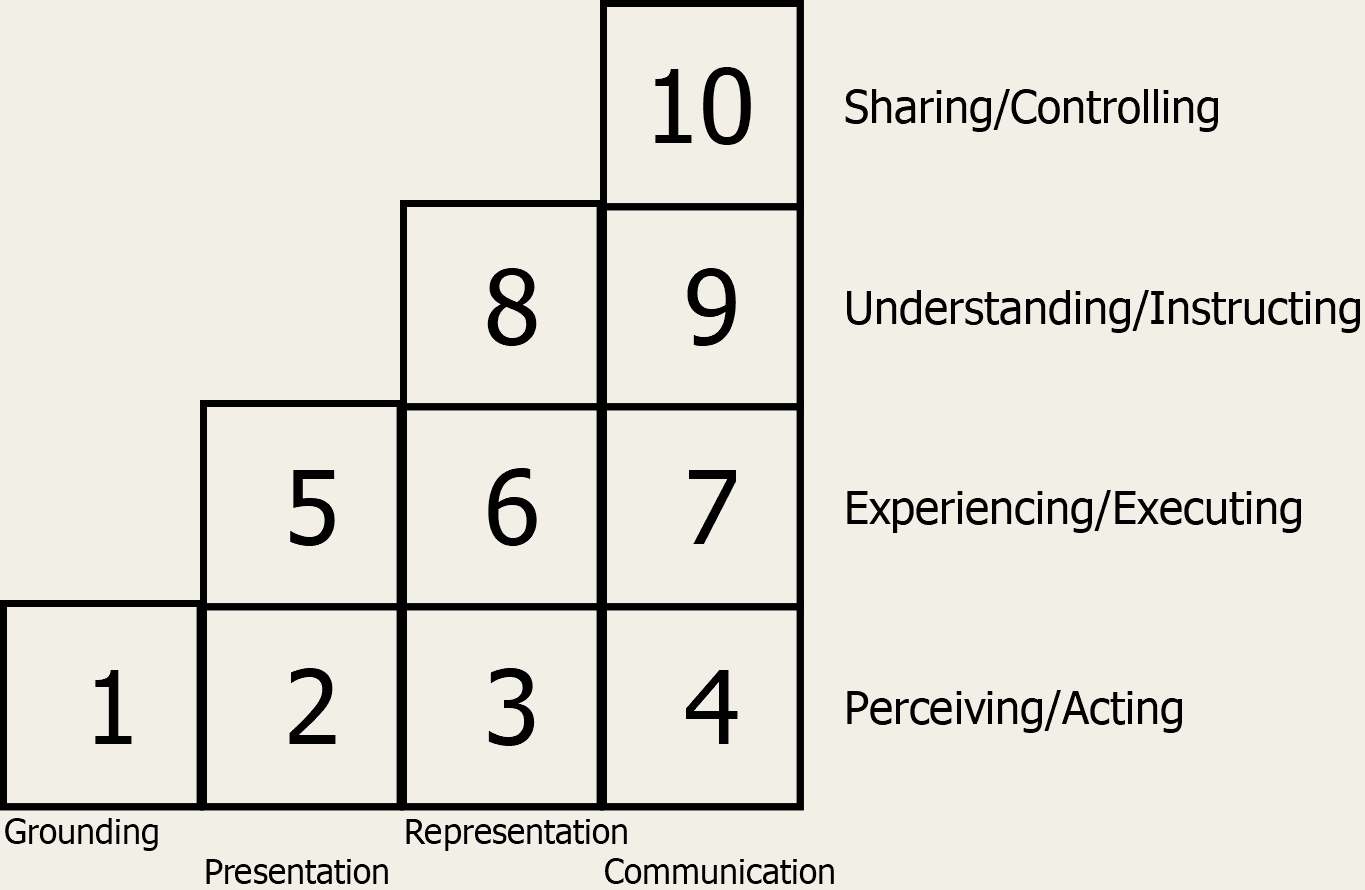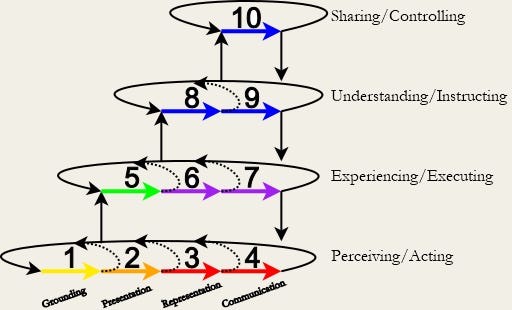Semiotics (10): Simplifying Semiotics
Exploring clearer terms by "desemiotizing" the 10 Stages of Semiosis
One of the challenges of semiotics is its complex terminology. While I've attempted to use simpler terms for the phases and periods, some terms like “Experiencing Presentation” are not exactly crystal clear. In this post, I'll aim to simplify the 10 Stages of Semiosis to make it more accessible and applicable. Towards the end, I'll apply these stages to the warning cries of animals.
We start with the diagram presented in the previous post:
As discussed in the previous post, there are feedback loops implicit in this diagram. We can make them explicit in the following way:
Simplifying the language
Next I will provisionally simplify the names of the stages. They are the following:
Quality = Perceiving Grounding
Irritation = Perceiving Presentation
Something = Perceiving Representation
Indication = Perceiving Communication
Pattern/Form = Experiencing Presentation
Familiarity = Experiencing Representation
Application = Experiencing Communication
Codification/Rule = Understanding Representation
Usage/Practice/Ritual = Understanding Communication
Discourse = Sharing Communication
This produces the following diagram:
There is, again, lot to unpack. For the rest of this post, I will use these ten terms to refer to the 10 Stages of Semiosis. The terms will be bolded for clarity.
Feedback loops
The horizontal feedback loops represent abductions, which are essentially guesses. Consequently, every stage is an abduction, totaling 10 different abductions that progressively build upon each other. Abduction is a "guessing instinct" rooted in the affinity between our minds and nature. Abductions result in hypotheses. The 10 abductions are then:
Guess producing the fundamental Qualitative diagram of space-time where we perform our inferences.
Guessing the possibility of fluctuations in those Qualities, some Irritation.
Guessing that there is Something existent behind those Irritations and not mere hallucinations.
Guessing that that Something is Indicating something; your attention is directed to the possible source of that Something.
Guessing the possible Form or Pattern embodied in that Indicated Something.
Guessing that the Form embodied by the Indicated Something may be Familiar.
Guessing that the Familiar Form may be connected to some Application.
Guessing that there may be a general Code or Rule regulating the Applications of those Familiar things.
Guessing that the Code or Rule may be embodied in some Usage, Practice, or Ritual.
Guessing that this Usage may be part of some universal Discourse. (I am not happy with this explanation)
Induction and Deduction
There are also inductions and deductions in the diagram. Together they form the semiotic bridges between the phases.
Induction
Inductions generalize and enable the semiosis to develop to a higher, more general, phase. If abductions produced hypotheses, inductions produce beliefs.
Inductions rely on repetitions. When something occurs repeatedly, an induction is formed. For example, consistently observing that dropped objects fall leads to the inductive inference that there's a living tendency for objects to fall.
Inductions produce new knowledge as we connect some general idea to a group of phenomena. When we note that a sample of a class of elements has some determined property, we can generalize that the whole class, from which the sample originated, has this same property.
In the diagram the inductions are the three arrows pointing upwards. The three inductions are:
Induction that the repeated Indicated Somethings share a similar Form or a Pattern, which makes them recognizable and, therefore, potentially Familiar in our experience. It is the belief that these Indications share a common “nature”.
Induction that repeated Familiar Applications share some general Code or Rule, that govern their instances. The induction enables inquirers to form the belief that the Familiar Applications are being guided by living laws and tendencies.
Induction that the Usage of some Code can be extended and generalized beyond the context, in which their Usage was developed. Usage becomes universal and, therefore, part of the symbolic Discourse that can be shared and communicated regardless of the context. It is the belief that the habits guiding the Practice have a universal nature.
Deduction
Deductions, in turn, are movements in the other direction, when already embodied habits are guiding and controlling the lower phases. We reason based on already embodied beliefs (developed by inductions) and apply them to the lower phases.
Deductions do not create any new information. We simply categorize and label encountered phenomena as belonging to some already established class or group.
In the diagram deductions are the arrows pointing downwards. From top-down the deductions are:
Deduction that a practical Usage/Ritual/Practice is a case of some already known universal habit.
Deduction that a particular Application is case of some already known habitual Usage/Ritual/Practice.
Deduction that a particular Indication is a case of some already known Application.
Fallibility
The fallibility of these different inferences is different. Abductions, being guesses, are the most fallible. We constantly guess wrong, although it is truly remarkable how good guessers we actually are.
Inductions can be fallible, because we can falsely generalize repeating occurrences. For instance we may infer that our favourite sport team always wins when we wear our lucky socks, and therefore our lucky socks are the reason for the teams success.
Deduction are the most secure form of inference, because if our premises, that is our already embodied beliefs, are true, the deduction will necessarily also be true. However, our beliefs may naturally be wrong.
Application
Let's consider applying this diagram to the warning cries of animals. Many animals have warning cries they use to communicate potential threats or dangers to their group members.
Just like everything else, these warnings begin with perception. Perceptual judgments about continuous Qualities grow into qualitative Irritations , leading to the perception of Something Indicated in that very moment. There is something there, capturing our attention.
Through persistence and repetition—via induction—the Form and Pattern of these persistent Indications become Familiar. These Indications share a common Form , allowing them to be grouped and remembered.
Due to terrible experiences repeatedly following the perception of this Familiar thing, the underlying tendency is understood to be something terrible. This Familiar thing is thus an Application of that underlying terror.
Familiarity with this terror produces a spontaneous cry heard by other animals. The cry embodies a Familiar Form (it always sounds the same) and is existentially connected to a threat perceived by others as well. Through persistent Applications of this cry, it becomes Codified and finds its way to become accepted Usage in the animal community.
However, the cries don’t develop into full symbols because they are only used in a dynamic relation with the threat. The warning cries aren’t part of Discourse in the animal community. Animals can't converse about the threat.
Perhaps some of our words have a similar history. Through continuous Usage in a specific context, they grew beyond it and became part of our Discourse. From that moment on, these signs could be used even when the predator was not actually present. This freed the signs to grow in meaning, and symbols like the word “snake” have a rich symbolic meaning in our Discourse
Thank you for reading! If anything is still unclear, I'll do my best to provide further explanation. This post is highly speculative, so feel free to ask any questions. For instance, the three inductions are practically indistinguishable compared to abductions #5, #8, and #10. However, as we move on to the 15 signs in the next post, I'll leave this system of 10 Stages of Semiosis to be further developed in the future, perhaps by others as well.
Sincerely,
Markus





